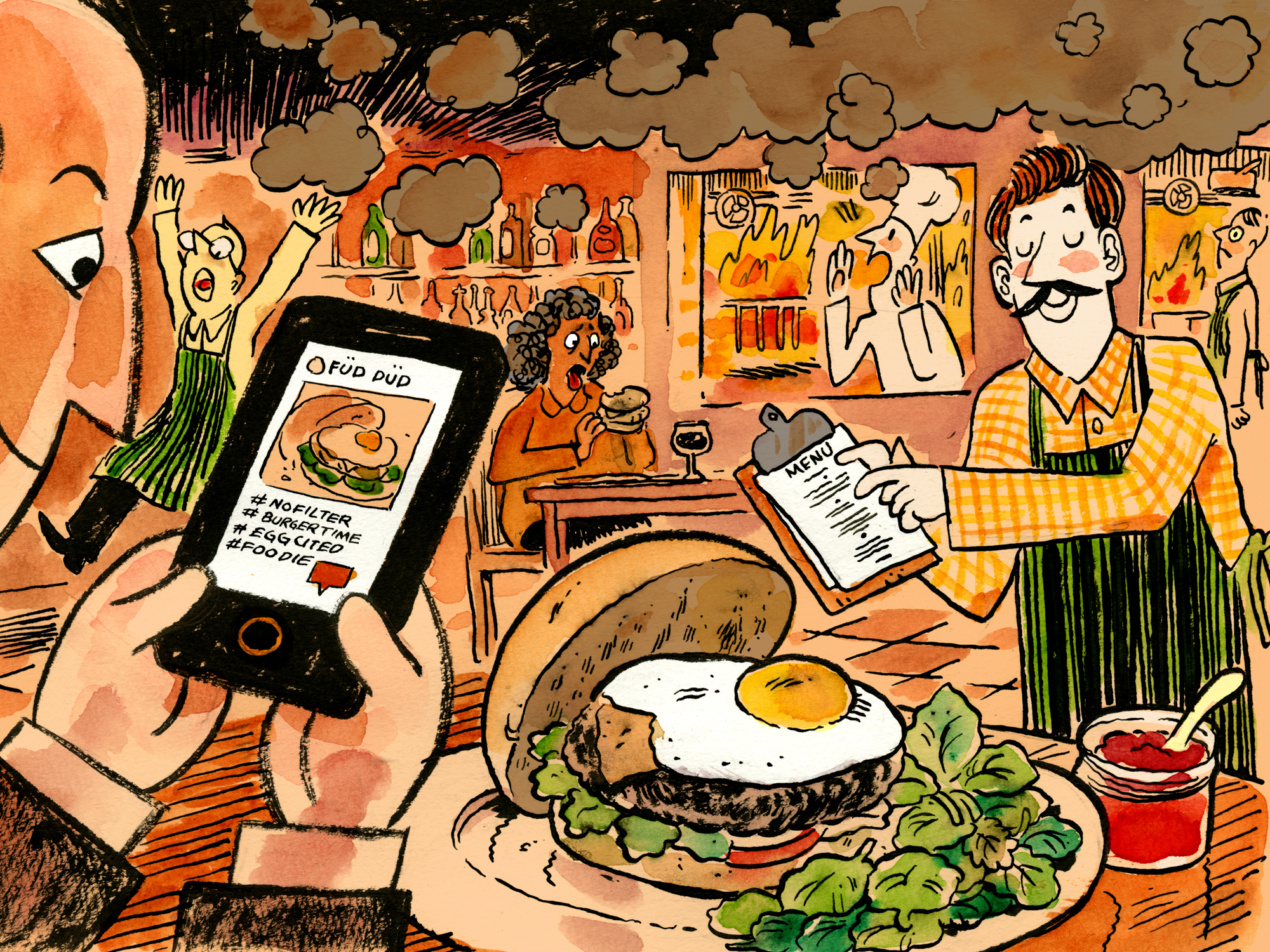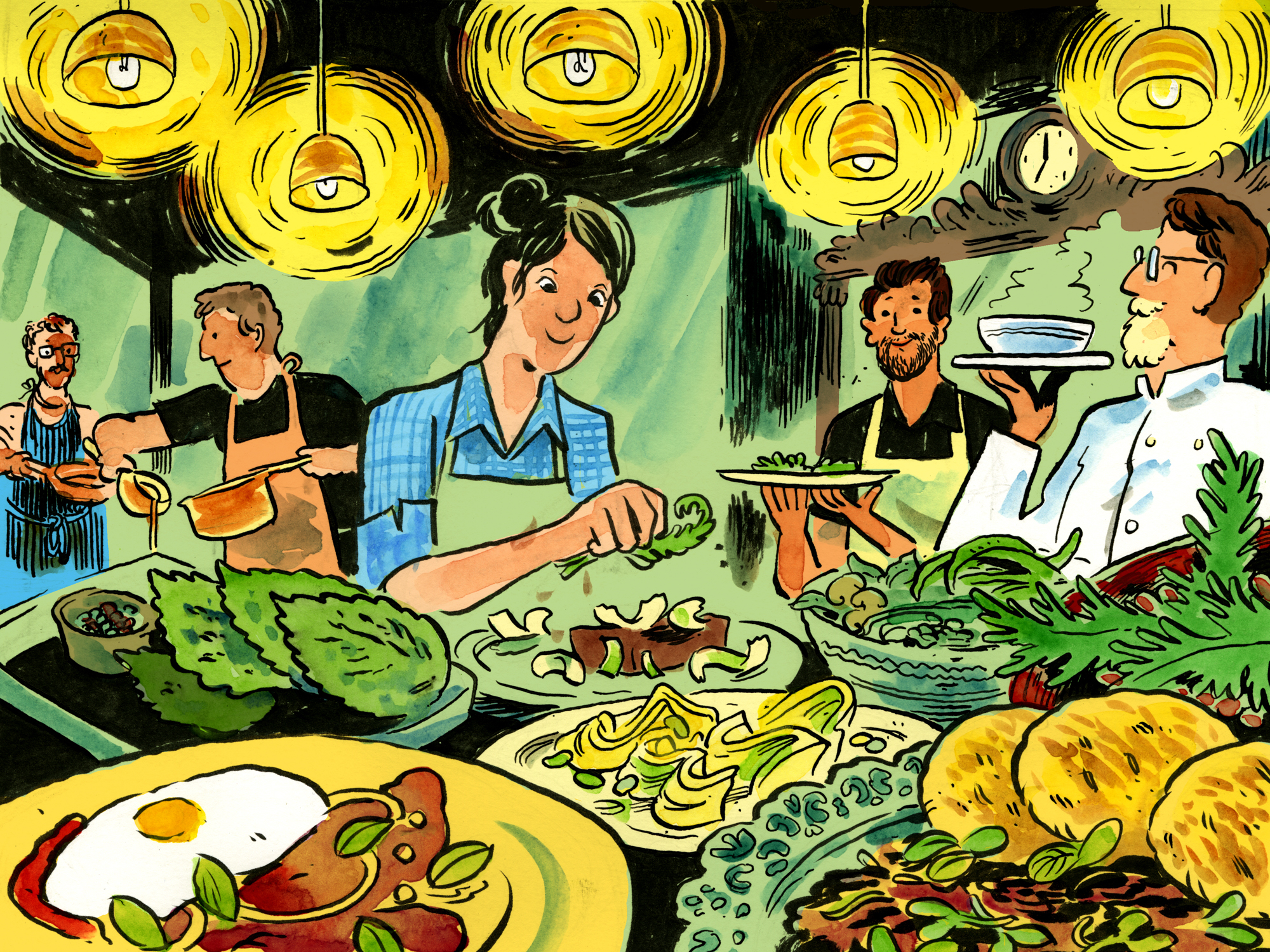WE WERE STANDING IN THE FOYER OF THE BOKA GROUP’S offices, hidden inside the building that houses Momotaro. The entrance is a kind of pocket-sized rotunda, with a blow-up of a magazine cover honoring one of the group’s chefs on each wall. One of the covers had scribbled autographs on it, and Jason Hammel asked Kevin Boehm about them.
“Mick Jagger and Ron Wood came into Momotaro, and they asked if there was somewhere private they could eat,” Boehm explained. “Because it’s awkward for them to try to eat on a big open floor like Momotaro’s, obviously. And I said, well, we have a meeting room in our office, we could serve you up there. So we brought them up here, and they said ‘Great, smashing,’ and Ron Wood said, ‘Could you get me a diet Red Bull, love?’ So I ran out and got Ron Wood a diet Red Bull, we didn’t have any here. And afterwards, they signed the poster.”
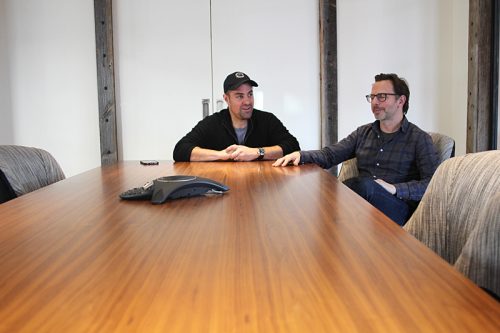
Kevin Boehm, Jason Hammel
That’s the glamour of the restaurant biz, getting to meet (and serve) the Rolling Stones. But as the eight or so people working at desks next to the meeting room show, there’s also a lot of just ordinary business to the restaurant business. Late 2016 was going to be a time that business would be heavy on Chicago restaurateurs’ minds, from a rise in the minimum wage in Cook County to federal changes in overtime pay for salaried employees, which would have had the most impact on exactly the pay range where most restaurant workers fall. (In short: before, employers were exempt from paying overtime for anyone making over $23,600 in salary; the new rule would have doubled that cap to $47,500. The expectation nationwide was that there would be a lot of shifting workers to hourly pay, or to fewer hours, to avoid higher payroll costs.)
My original plan was to gather two or three restaurateurs of different business models and talk about the impact of those regulatory changes. Then in the few days between setting up the meeting and having it, a federal judge in Texas struck down the overtime pay rules. But it quickly became clear talking to Boehm, co-owner of the group that’s created big downtown restaurants from Boka to Girl & the Goat to Swift and Sons, and Hammel, who has owned Logan Square’s pioneering farm-to-table restaurant Lula Cafe for 18 years, that the business challenges for the restaurant industry run deeper than regulation, and any smart restaurateur has been thinking hard about them for a long time.
So we still had our conversation about two very different models for Chicago restaurants—the creator of downtown trendsetters and the farm to table-focused neighborhood anchor. But it took in much wider territory, from what is just pay for people in the restaurant industry, to the disparity between what front of house (servers, who get tips) and back of house (cooks, who don’t) earn, to how owners need to achieve work/life balance for themselves. Here’s our conversation.
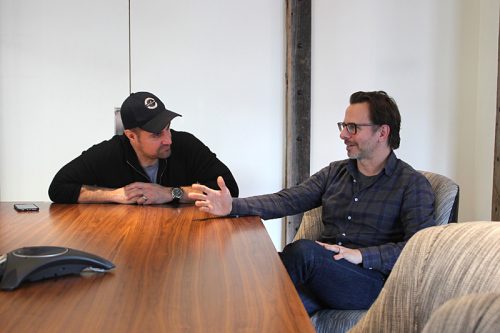
I. The math of making food
FOODITOR: So I gathered you to talk about the economic situation, which has now changed in the case of mandatory overtime for salaried employees. But I get the impression that you were both thinking about changing how your businesses work in terms of pay structure and so on, regardless of that.
HAMMEL: We’re still actively restructuring Lula to accommodate that change, even though it’s been struck down. And we’re thinking pretty hard about how many hours people should be working, and what the compensation packages are for those people. Because the old status quo has been untenable for a long time.
I have a restaurant that’s 18 years old, so it’s very entrenched in the status quo. And part of my challenge in maintaining that relevance is to change that structure. We’re looking at January 15 as a deadline, and we’re going to take people off salary and put them on hourly. That’s a reaction to the regulation, but it’s also a reaction to the fact that there are different types of employees. There are some that want to work 100 hours a week, and there are some that don’t. I don’t think the ones that don’t should necessarily be penalized for the way they’re thinking about their lives.
BOEHM: I think the biggest challenge with the law was that it kind of ruined the meritocracy. Because there’s a cap on certain positions and depending on how much the restaurant grosses, there’s only so much you can pay for the restaurant to still be financially viable. If the floor is $47,500, it changes the way you have to think about the way you structure your restaurant from a financial level.
We’ve restructured, too. In order to compete, and to compete for the best people, back of the house people have to make more money. It’s a fact. So we just kind of like, shook the whole model up and said, you know what? Okay, we’re going to run a higher labor cost. That’s a fact, and that’s not changing. In the old days, when I first moved here, our model was 30% cost of goods sold, 30% labor, we wanted to pay 4% occupancy, and then “silo” was our madeup word for everything else—supplies, insurance, lease equipment, other. We wanted that to be at 18%. If we did that, there was 18% left at the end of the day, that was what you strived to do.
You can’t run 30% labor any more. You shoot for 35% or 36%.
HAMMEL: I like that term “silo.” Just throw it in the silo—and hope it doesn’t burn down….
But you need to find successes in that area, because your labor costs are going up no matter what. There are some people for whom that might not be the case—your larger companies like Chipotle or McDonald’s or something. But in terms of the valuation of food and food experiences, restaurants in the middle to upper range are going to need to raise prices. As well as expecting higher labor costs—
BOEHM: You have to get it back on the cost of goods sold. That’s where everybody’s going to have to make it up.
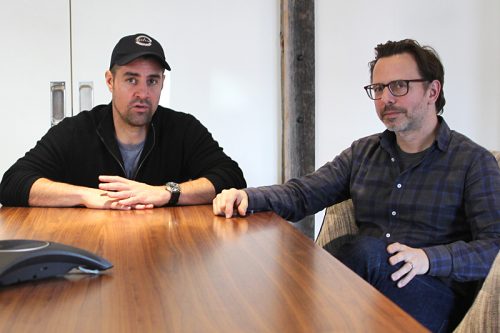
We’re still talking about a business that’s really like a 90% failure rate. The way I’ve always looked at it is, there’s 90% that fail and the 10% that succeed control the market. So who are the 10%? The 10% are the people that figured out how to meet at the intersection of artistry and financial responsibility. Those are hard people to find, right? That can think in both those directions. Sometimes it’s balanced by two people, one person is the artistry and one person is the financial direction. They try to meet in a room together and get along, which is not always easy.
We kind of came at this business from both sides. I opened my first restaurant 23 years ago, with the money I’d saved bartending and waiting tables, and I was 100% artist at that point. All I cared about was that there was money in the bank at the end of the month. And any money I made, I wanted to put back into my restaurant to make my restaurant cooler.
Then you get to a point—we have 1400 employees now. So there’s a lot of people that count on the financial viability of all the restaurants. You have to think about things in both ways, and I’ve definitely changed throughout the years. I’d say I’m 50% artist and 50% businessman, that’s where I try to sit. It’s where I like to sit.
Do you limit those people to four days a week? How does a restaurant that’s searching for brilliance have sous chefs who only work four days a week?
HAMMEL: But you must be in a position now where you really focus on the “silo,” on the deal, on the rent, on the overhead costs, on how many seats you can have in that space—
BOEHM: Correct.
HAMMEL: Because basically, costs of goods sold is pretty much fixed, and labor costs are going up, so the deal becomes the magical thing.
BOEHM: It does.
HAMMEL: It also means that the real outsiders in the industry have to go further outside to be able to make it work. Look at Logan Square and the rents—I have a perfect view of the rents in Logan Square, and the change there means that explorations are on the periphery—Parachute, and Jason Vincent’s place [Giant], are in peripheral locations and financed tightly—”We’re barely able to make it.” That’s why I love the name Parachute—it’s like, Oh fuck, if this thing doesn’t open up and save us, we’re going to be dead. But we’re holding on, because it’s all we’ve got. I think it’s an amazing name, it inspires me every time I think about it.
Let’s talk about what these structural changes mean for employees. Take me through a couple of scenarios of what this is going to mean for an employee. If I work 30 hours a week front of the house at Girl & the Goat, what’s going to change?
BOEHM: Front of the house is not going to change. We have a tip credit [allowing employers to pay a base wage below minimum wage to tipped employees] in this city; that’s a good thing; servers don’t make $15 an hour, that makes it really tough on the restaurants. And the servers at good restaurants in Chicago make great money, and have a great life.
HAMMEL: They do. They don’t have to work 90 hours a week, they don’t have to have two jobs, most of them, and a lot of my servers work at Lula because they are producing a film, or on tour with their band, or working on their Ph.D, or whatever. And they’re still able to do that.
BOEHM: And don’t get me wrong, these people work very hard, they’re great, great respect, it’s how I started—but there are servers who make $100,000 or more in this city. It’s a good life.
And what I think a lot of people have been trying to do is close that gap between the back of the house and the front of the house. Let’s go back to 2002, 2003—you were getting starting line cooks making 9, 10 bucks an hour. And guys prepping for $3.25.
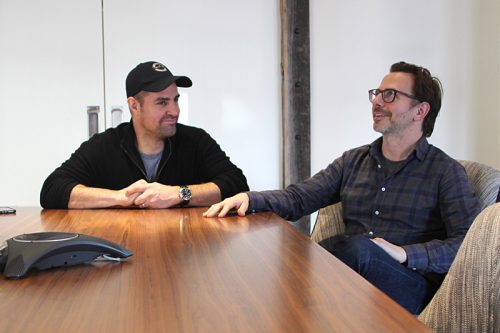
HAMMEL: And if you went back just a year or two before then, shift pay was everywhere. Do you know that term? There is no shift pay now, it’s outlawed. But shift pay was, when I first moved to this city, you’re gonna make $400, or $350, a week.
BOEHM: You’re gonna make $70 a shift. No matter what hours you work—
HAMMEL: And here’s your prep list. Just be ready at 5:30. And you’re like, when does the door open? The cleaning crew is here at 7, so I’ll show up at 9 and be here till midnight. So that was for $70!
That’s gone. But not far away is the sous chef in the 30s, a mid-30s salary who’s got a lot of work to do. Honestly, the nicer the restaurant the more labor there is to produce the food, that’s clear. And if you’re peeling salsify, it’s going to take a couple of hours. So those people are stuck doing that work for longer hours. That’s where the focus has been for me, is the sous chef.
And they would have gotten overtime for that.
HAMMEL: Under the new rule they would have. Unless you’re going to pay them $47,500, you’re basically paying them hourly.
BOEHM: You can do the math. Most cooking jobs, they’re going to do five ten-hour shifts, minimum. And so you’ve really got to look at the job as 40 regular hours and ten overtime hours. It’s pretty easy to get to $47,500 when you’re paying overtime for those ten overtime hours.
HAMMEL: The people that I’m thinking about that I’ve moved are longtime employees, and I’m not going to cut their wages, so that means a hit for me. When new people come in, they’ll work their way up, and I think I’ll be able to tighten my labor costs that way. What it means for them is, they’re not going to be working—most days are 14, 15 hour days for them. So they might clock in twelve-hour days, and there will be one short day where they come in, expedite a service and leave, which is currently unheard of for them.
But is that what you do? Do you limit those people to four days a week? How does a restaurant that’s searching for… brilliance, have sous chefs who work four days a week? I mean, they need to talk to each other, they need to commune, they need to team build, they need to watch service, they need to know when the product comes in and jump on it—it’s really hard to manage a restaurant like that.
But that’s the challenge. That’s what we have to face.
BOEHM: That’s why I think you just have to blow the model up a bit. I think that restaurant prices stayed the same for a long long time, and prices have to go up a bit.
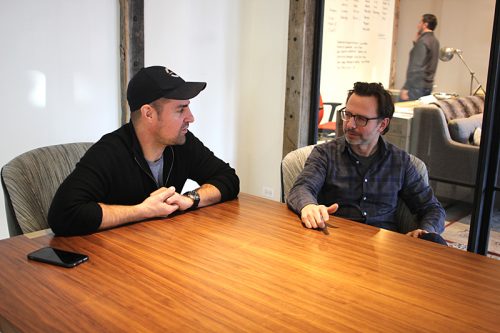
II. Apprenticeship and experiences
FOODITOR: That leads to something I’ve thought for a long time, that poor cooks are basically subsidizing rich people in the dining room. There’s an enormous amount of labor that goes into my precious experience in the restaurant, and even at the high price, am I paying fairly for that? Apparently not, if cooks are not getting paid fairly.
HAMMEL: There’s another road that’s running alongside this conversation, which is that for the last 20-30 years, there’s been an artisanship system, an apprenticeship system that functioned at restaurants like that. Where you basically go in there to learn a trade—
BOEHM: It’s graduate school.
HAMMEL: Yeah. So you’re willing to work the hours, and take the lower wage, as long as the experience you get is educational. That’s really changed in the last couple of years with the mindset from the young cooks who come in—not that that’s a bad thing, but it’s definitely different from when I started.
BOEHM: There’s also the growth that you could get from working that apprenticeship, becoming a great chef, who could eventually become a celebrity chef, or own three restaurants. There’s some serious money to be made. The front of the house is different, the front of the house is this bargain that hey, you’re going to make really good money, but it’s going to be flat, it might not get any better. Once you’ve gotten to that hot restaurant where you’re making a lot of money, that’s maybe the best you’re ever going to do.
Where for a cook, there was this growth, where you would come in and you would apprentice, and then you were a sous chef, and you’d make a little more money but you’d work even harder and have even more stress, and once you made that executive chef position, there’s a chance to show your true voice. And from that, you could become something really big, and that’s the chance that a lot of these people are taking.
I think the key at this point is not just creating a great restaurant, but creating a really signature culture within your own restaurant that makes people want to stay and work for you.
HAMMEL: Although it does feel a little different right now, because there’s such a glut of restaurants. The shine is off the industry a little bit, I feel. The celebrity chef isn’t as exciting—it was a hot moment for a few years. I feel like there’s less energy in that part of the industry, and that’s why all of us have struggled, or are fighting hard to keep our back of the house staff. Because there’s so many restaurants, and not as many people who are on that path to chefdom.
BOEHM: Eighteen years ago, there weren’t a lot of you who did what you do.
HAMMEL: And it’s changed so much. The mid-scale restaurants… they’re just better. Their food is great. How many people are doing charcuterie in the city right now? That wasn’t the case 20 years ago.

But the labor pool is starting to wane a little bit and if you go to a bunch of line cooks at these restaurants and see how many of them are convinced that they want to be executive chefs, you’re not going to get 100%. You’re going to find a lot of them confused about what they want to do.
Is that just because so many more kids went into this as opposed to whatever the hot career was 20 years ago?
HAMMEL: They’re disillusioned, yeah. Are people still interested in Top Chef and Chopped like they used to be? The culinary schools are closing—we had this bubble of schools, and now it’s shrinking. It’s going to be an interesting time. The next ten years are going to be fascinating. This winter’s going to be fascinating. If we have a rough winter this year—every winter restaurants go up and down.
BOEHM: I think the key at this point is not just creating a great restaurant, but creating a really signature culture within your own restaurant that makes people want to stay and work for you. I think we’re all kind of starting over a bit, and we all have this blank canvas and we’re like, hey, why can’t we do that? We’re trying to create a lot of cool stuff for the people who work within this company to feel like they’re part of a cool culture and want to stick around.
Do people hop around within your group?
BOEHM: They do, and we’re hoping that they do it more. We say to them, hey, we know the routine, you’re going to go work for Jason or Rick Bayless or whoever and get your year in, we hope you do it a few times within our own company.
HAMMEL: You have enough diversity within your own company to have that really make sense.
BOEHM: Mark Hellyar [Momotaro] and Lee Wolen [Boka] and Stephanie Izard are very different chefs, we’re trying to pick chefs who cook differently so people can hop and do that.
HAMMEL: I’m about to leave after this meeting and go to new server training, and the first thing I’m going to do is just walk around the room and be like, This is how it started, this is what this room is, this is what it used to look like—Boka is the same way, right, people who start there don’t know the history, they need to be informed of everything what’s happened before that—
BOEHM: There’s something beautiful and special when Rob [Katz] and I walk into that restaurant, I get a different feeling from the rest of our restaurants.
HAMMEL: I think the history is super important, and part of what we are always talking about in staff meetings. Like, this customer did this the first couple of years that we were open, just letting them know the stories behind stuff.
BOEHM: You’ve seen people grow up and get married and have babies within your restaurant. And one thing we always say when a new restaurant opens, I said this at the holiday party last year. People over the years have chosen our restaurants to propose in, and—there was somebody who went to Girl & the Goat recently who was in the final stages of cancer and it was on their bucket list to go to Girl & the Goat, they flew into Girl & the Goat. You can’t get much bigger than that. People are choosing our restaurants for some of the biggest moments in their lives, to share in our places and break bread. That’s pretty amazing, and pretty special. That’s part of the culture that we’re trying to build.
HAMMEL: That’s where the value is for the employee.
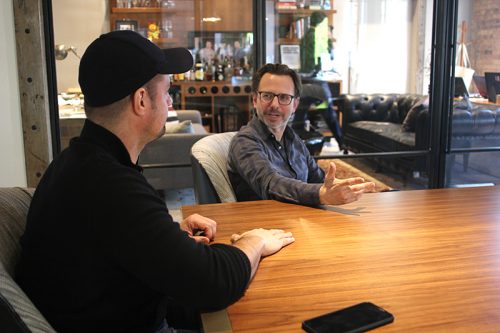
III. What the customer doesn’t see
FOODITOR: What are some things that you’re doing that the dining room customer will never see, but that help you survive and run better?
BOEHM: I think we’ve both accepted the fact that our labor costs are going to be higher, and that Rob and I are good enough businessmen to find it in other places. From a business side, we’ve looked at every single thing that we do—that’s the power of having this many restaurants and of leveraging every single thing you do in every single category, and saying, I’m going to find my dollars here.
HAMMEL: In the silo.
BOEHM: And in some cost of goods sold. Looking at beverage, looking at food, all that stuff.
Which is what the big big companies, the McDonald’s of the world, do—shave a quarter of a penny off a slice of cheese and that’s ten million dollars for them.
BOEHM: That’s exactly right. It’s not lowering the quality of anything, you’re still getting it from these great places, but you’re saying hey, we’re buying green beans from this farm and this farm and this farm, these green beans from this farm are really good, maybe we buy them all from this one farmer. That’s a very simple example, but that’s the way we can look at a lot of these things.
HAMMEL: I have less ability for that, hardly any, but what we looked at was just, let’s bring more money in. You guys do a lot of catering, catering has been really helpful for us this year.
BOEHM: Catering rules.
HAMMEL: We’re doing that out of the same facility, it’s hard because people get bogged down by it sometimes, but the percentages are better, you can charge a little more. And catering has really helped us pay the employees better.
BOEHM: We do a lot of weddings, we do a lot of holiday parties. We just did Chicago Children’s Choir’s gala—that was an 800-person sit-down. Catering is its own animal, we’ve been doing it six or seven years now.
Where does it come out of, your regular kitchens? Does that work, to have one guy making someone’s dinner and someone next to him making 400 canapés?
BOEHM: Sometimes. We’ve got prep downstairs at Boka, Giuseppe [Tentori] is our partner in the catering company and he might be down there getting things ready.
HAMMEL: Giuseppe and I have shared some Sunday morning commiseration about late night Saturday catering gigs [laughs].
One of the things I try to do in catering is, we’re a super-seasonal restaurant, right? So I’ll write you a menu, but when we get a little bit closer I’ll write you a little bit different menu. And then we tie it in to what’s in the restaurant, so if we have roasted beets, maybe we buy 100 pounds instead of 50 pounds, and a guy spends an extra hour peeling them. So that’s one way of maximizing your labor costs.
So basically catering is a way of having better time management?
HAMMEL: I feel like we utilize our time pretty well, but it’s a difference in terms of how much money is coming in during that hour. Going up by 50%, if we’ve got a party that day.
Other things we’ve done, concrete things—we’ve moved some managers off salary onto hourly, and put people into positions of responsibility that were formerly assumed by managers. Like expediting. We’ll train a line cook to expedite, so we can get a sous chef off the line, so they’re not there for 100 hours a week.
Our product costs a lot. And that’s why we’re fighting for it. And sometimes that’s why I get my back up about expectations for value.
BOEHM: One of the things we’re trying to do too is to add a lot of value-added stuff to managers…
[He holds up a printed card summarizing benefits for employees.]
This is kind of our benefits stuff that we do. One, all the managers and sous chefs eat for free in all the restaurants. That’s a pretty big swath of restaurants. We’re giving free gym memberships to all the managers and all the sous chefs, through West Loop Athletic, and then we’ve got perks and discounts through various companies, we’ve got a lot of social activities, and we’re starting a kind of scholarship program. Each restaurant’s going to put a certain amount of money into a pot, and at the end of the year every restaurant’s going to nominate one cook for the scholarship, based on their performance or their backstory or whatever, we’ll interview them all, and then one person’s going to get this scholarship to further their education in whatever they want to do.
This all sounds pretty good, even hopeful. But I know when you, Jason, were at Taste Talks, you and Andy Ricker sounded pretty dire about some aspects of the industry—
HAMMEL: Hey, I just said it was going to be a bad winter!
I’ve been through a situation where you look at a restaurant and you’re like, um, it’s not performing the way that it needs to perform and I don’t think it’s ever going to, and my energies will be better used elsewhere. Even though I love it. I’ve been through that situation, which is a form of heartbreak. And there are plenty of people in the industry who’ve all closed restaurants and learned from it.
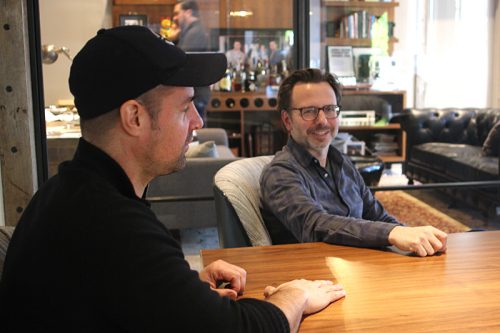
I think there will be some more, in the next couple of years, as the market reacts to some of these changes. Do I think that this situation is dire? If we can’t raise prices—I’ll continue to raise prices incrementally, and if there’s some sort of backlash against that, I think it will be pretty dire. Unfortunately, people are eating out a lot—well, I’m happy that they’re eating out a lot, but they’re expecting a lot of experience for not a lot of money. This is my adopted city and I love it, but sometimes I get frustrated with Chicago because it has a fetish for cheap eats. Even in our, in the upscale field, the $1 oyster hour at a place that does really great seafood—it kind of pisses me off.
BOEHM: Sorry, man.
HAMMEL: You do that?
BOEHM: We’ve done it at Cold Storage. During happy hour.
HAMMEL: I didn’t mean to offend—
BOEHM: No worries.
HAMMEL: But the idea, I can get this much food for this much money is the context when you go out to dine at one of our restaurants.
BOEHM: I do agree with you. We don’t do any discounting in the entire company, we don’t do any coupons. We were just doing that during happy hour. But I completely agree with you.
I think people have a misconception sometimes of what value truly is. Sometimes they think value is a massive plate of pasta at Maggiano’s, where they run a 20% food cost. Where they get three pieces of fish at Momotaro and they’re like, “$16!” Just at the sushi bar at Momotaro, we run like a 40% food cost. We’re getting fish directly from Tsukiji market four times a week, it is not cheap. We made that bargain in the beginning, we’re going to try to run a little lower food cost on the Japanese seasonal food and run a little higher at the sushi bar and get the best fish we can in the city of Chicago.
But you know that, Jason. You pioneered getting beautiful product in this town, and that’s why you are who you are.
HAMMEL: Our product costs a lot. And that’s why we’re fighting for it. And sometimes that’s why I get my back up about expectations for value, and how much food should be on a plate, and of what provenance.
BOEHM: Do you feel like your neighborhood sometimes dictates a certain price?
HAMMEL: I do feel like that. I also feel like our success lies in our brunch service, and that has a valuation that hasn’t really changed at all since we started. We’re probably one of the most expensive brunches around in terms of price per entree, because we have to be given the farmer product we use, and I would like to see those prices go up. Because the classic brunch places that are packed every weekend, they really haven’t raised too many prices in the last few years.
But whatever, we all have money issues and obviously people are struggling out there and they’re not just going to pay whatever we want them to.
But apparently a lot of people aren’t struggling, to judge by a neighborhood like the West Loop, where you can open a giant restaurant and it’s packed every night.
BOEHM: You can fill a restaurant in the West Loop. The people are here.
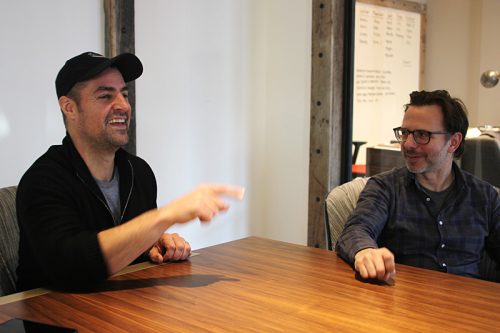
When we opened Girl & the Goat, I think I got knocked over by a tumbleweed walking into Girl & the Goat [laughs]. In late 2009, when we were building that property out, literally everything was going out of business. Every single building was for lease around here. There were people who were like, why are you guys moving over there? It’s getting kind of dead on that side.
And obviously that’s completely changed. The density’s here—I didn’t think the density would be here for lunch for a long time, but it’s changed.
When I worked in the Loop, no one would have gone that far for lunch no matter what it was. (Well, I would, but not a normal person.) And now it’s routine to shlep twelve blocks and cross the expressway for lunch.
BOEHM: Hot Doug’s was in the middle of nowhere.
HAMMEL: Hot Doug’s is a perfect example of just, owner-operator magic. If you build it and it’s really good, people will go.
BOEHM: Greatness in this town—throwing Chicago some love here, you don’t have to dumb anything down, and if you can build greatness, people will come and they will find it. But greatness is hard.
When we started, we built three restaurants in Lincoln Park, and honestly, we were scared off by the rents downtown. “They’re paying how much? I want to stay down here and pay our $15 a foot.” That was actually our attitude—we were really happy being the middleweights. “That’s for the heavyweights down there, let them do that.” But eventually you look at it on the spreadsheet, and the density’s there, and you can be busy at five o’clock and at eleven o’clock. And that made the move make sense.
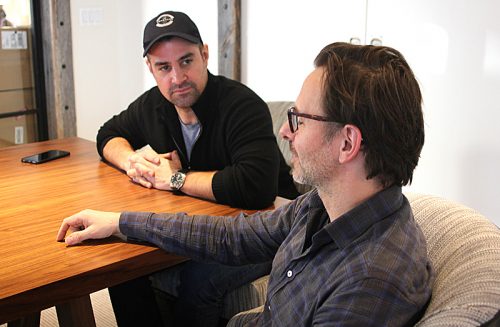
IV. Owners: get a life
FOODITOR: As we were getting set up, Kevin was talking about what you have coming up—and you said you and Rob have decided to take 2019 off from opening more restaurants, for your own sanity. Tell me about that.
BOEHM: We have four projects in the works right now, and so we blocked out 2019 as no new projects. ’17 and ’18 we have projects, but ’19, we’re just hoping it’s calm. We made a promise to each other, no matter what….
The problem with our company is, it stopped being about our ambition level a long time ago. You have people in the company, and when Stephanie says Hey, I want to open up a restaurant, you say, All right, it’s not perfect timing but if that’s what you want to do… That’s how growth happens, because you’ve got to provide opportunities for people or you’re going to lose them. We’re finally gotten to a point where everybody’s kind of got their plate full.
For you, Jason, if you have to trim back a sous chef’s hours, your first inclination is probably to do the extra work yourself, right? But that’s not good for you, either.
HAMMEL: The model at Lula is that Jason works ridiculous hours, and so if you’re a manager, you think I’ll just have to do that myself. That’s a challenge for me personally that I’ve always had to think about, and right now I’m working hard at figuring out what role I should be taking as a model for what a good work week looks like, or what a healthy balance is.
The stress and toil of restaurants is, at once, addictive and also detrimental to people’s physical and mental health. Giving gym memberships for restaurant managers is a great idea, because they have to burn it off some way that’s like, not about drinking.
BOEHM: 100 percent.
HAMMEL: Which is really a problem in the industry, you know that. And that’s really where a lot of the stress relieving comes in. So a work/life balance is important, and being the kind of company that promotes work/life balance as a company value is important. It’s different for a 1400-person company but for me, I just have to show that I’m personally capable of work/life balance, for my chefs and chefs-de-cuisine to say it’s okay, come in later, work the shift, someone else will take care of this and that, and, like—go running tomorrow. Take care of yourself. Eat before you start working, or whatever it is, and those are the things that will make for a good workplace.
BOEHM: From 1993 to about 2009, 2010, I had terrible work/life balance. You see all those people working in this office, and then we have a separate financial office—in 2011, it was me, Rob and Ian [Goldberg]. We were still doing all the financials. We opened seven restaurants between 2010 and late 2012. And at the end of it, Rob and I, and Ian as well, were all basically having a nervous breakdown. There was a moment when Rob put his hands on my shoulders, we were both about to cry, and he said “What are we doing to ourselves?” And I said, “I don’t know.”
We all sat around and tried to restructure everything, and we were restructuring our own lives, and all of the restaurants through the managers and the chefs and the sous chefs, trying to figure out how everyone could have balance. Because we’re all going to be better and more effective within the restaurants.
We’re still trying to have that happen. It’s certainly not perfect. The way restaurants are set up, people really have to work their asses off—
HAMMEL: For it to be good. To be mediocre, you can go home.
BOEHM: Yeah. Listen, we could both change all our restaurants to being open Thursday-Friday-Saturday, we’d lose a shitload of money, but on those three days the restaurant would be killer.
HAMMEL: That’s the thing. Restaurants do need constant observation of management. And people who are good at it see everything. You walk into Boka, I’m sure you’re just scanning it like the Terminator.
There were so many years where we had our arms completely wrapped around everything. You have to let individual people make decisions and change things.
BOEHM: And you know what happens now, because I’m not at every single store all the time, you go in and you go, “When did that happen?” Or you see something—our director of operations actually had to tell Rob and I, “If you see something, you might not know that something changed. Why don’t you work it through me.” Because we would go into a store and we’d be like, “Hey, don’t do that,” and they’d say, “Uh, the SOP on that changed.” That was one of the hardest parts of getting big, because there were so many years where we had our arms completely wrapped around everything. You have to let individual people make decisions and change things.
HAMMEL: It’s that tension between omnipresence, and having a life. Like, I’m a morning person, I want to get up in the morning, I set my alarm for five. But to do that, you gotta get out of work earlier. And like, last night I was working, and I didn’t have to be there, but Abe Conlon came in, and then a couple of other industry people came in, and I started talking to them, and I wanted to make sure their food was all right, and I had a server who left us after nine years so I wanted to say goodbye to her—and then the next thing you know it’s midnight.
BOEHM: I’m sure you find yourself making decisions where 15 years ago you would have been, okay, I could have a beer with this person or I could go home—
HAMMEL: I go home. And also, back then I had no kids, and my body was a lot more resilient then that it is now.
I’ve missed a lot of my kids’ lives. And it matters to me to be there for them and to be really present. And to be really present means being rested. The same way you’re saying about having the right rest, and exercise, and being well-fed at work, you’re going to make better decisions and be more present—home is the same way. When I talk to my daughter, I don’t want to be zoning out, or thinking about something else.
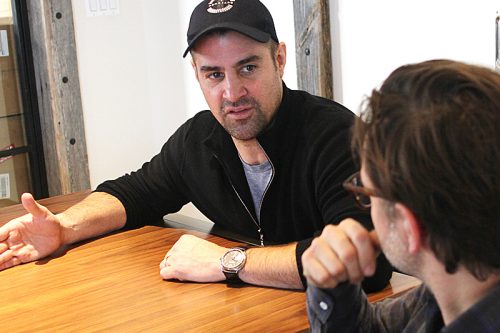
BOEHM: We just started something, once a month, where we have breakfast with myself and Rob and Erin [Phillips], our operations director, and Ian, in this room, and anybody at the restaurants can join us, they have to sign up so we max it out, and they can just ask any questions they want to.
It’s an open forum and it’s a really great touchstone for the restaurants. You hear about a lot of this stuff, life balance or what they’re not getting benefit-wise. Successes at an individual store level, failures at an individual store level, and I love that we’ve been doing that—we’ve learned a lot and changed little things within the restaurants just by hearing and listening to people. We’ve tried to make the conversation like, you’re in the safe zone. We make it really non-formal—I try to wear a hat and a T-shirt that day.
HAMMEL: Similarly, when I do this conversation with new staff members today, I say, this is my phone number, this is my email address, you can reach out to me. Because a lot of people don’t find me that approachable. It was funny, yesterday in a staff meeting we were preparing for this and I said, what would be the one thing that you would tell a new employee who starts here, that you should have know when you started? And somebody was like, that you’re actually warmer than you seem. So that’s a good system, to get conversations going.
But basically, for the last hour we’ve been talking about culture in the restaurants, and how to make that a healthy culture. And I think if you go into the really successful restaurants they have healthy cultures that all have the same qualities—like access to the ownership, and ownership that gives a shit, and actually expresses that and gives feedback—
BOEHM: People that are willing to look at themselves in the mirror, and be critical of themselves, too. I think that’s the key to a restaurant evolving and being able to survive for 18 years, is to be able to look at yourself in the mirror and be able to change.
When you open up a restaurant, everything’s really clear. We’re going to get these six reviews and we want them to be really positive and we want to be busy and we want to achieve this—when you get to year three or year four those goals stop being so concrete. You’re not getting reviewed any more, and you have to create your own goals. You have to say, here are the ten things, both material and real, culture-wise, that we want to accomplish this year. That’s one thing that we’ve started doing with all the restaurants, sitting down with everybody and saying, okay, what are your goals for the next year? Who do you want to be?
HAMMEL: If the culture here is really exceptional, how do you communicate that to guests? Employees need to express that they’re well taken care of at the table, Danny Meyer would say, because if you’re taking care of the employees they’re taking care of the guests.
Where my head is really at, I guess, is that if I’m going to charge more money for brunch, the communication has to be, well, this is where the eggs are coming from, this is where the butter is coming, this is where the bread is coming from—
BOEHM: We pay our cooks more—
HAMMEL: All that stuff. We’re paying our cooks better, we’re not overworking our managers, we compost, or whatever it is. The things that you communicate have to become deeper, and the thing is, does a customer want to hear that over two eggs? These are some of the challenges that I think we’ll have to face in the next year or two.
BOEHM: I think the consumer does want to hear that. I think when a consumer sees that everything within a company seems tight, from bathrooms being clean to their website having an updated menu, all those things before they’ve even tasted a bite of food, by the time their food comes, they just have this idea in their minds that everything is just as organized in the back.
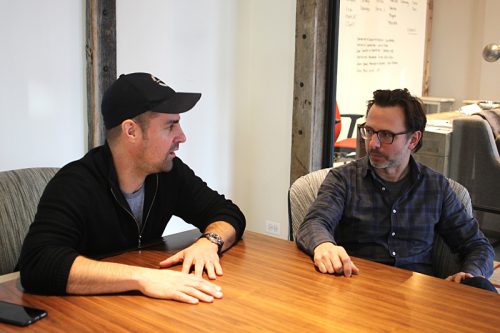
So if you can create this atmosphere around you that shows that, not only are we doing these things that are hospital corners around the restaurant, but we’re also doing that the way we take care of our people, the way we pay them, all that sort of stuff, that creates an even bigger feeling of trust.
What upsets me is when somebody comes out with something that’s of low quality, and they’re open for eight months, and then they close it, but that $1.7 million that they did in those eight months while they were open sniped all these good restaurants. Because we’re all competing for the same pie. I’m not worried about competition. I want good things to open. I only get upset when stuff opens that’s not very good, and they don’t treat their employees well, and the money they made in the short amount of time that they were open could have gone somewhere else that does the right things.
HAMMEL: We’re going to have to do a better job of communicating all the things that we are passionate about.
I mean, is the picture dire? I was pretty negative in that conversation [at Taste Talks]. I was also in a dark basement, and this is a sunnier, well-lit office, so maybe you just feel better about it here. I’m hopeful, I guess, or I’d be out of this business.
Michael Gebert treats all of Fooditor’s employees like they’re the editor of Fooditor.
Latest
Join the Discussion
After you comment, click Post. If you're not already logged in you will be asked to log in or register with Disqus.





